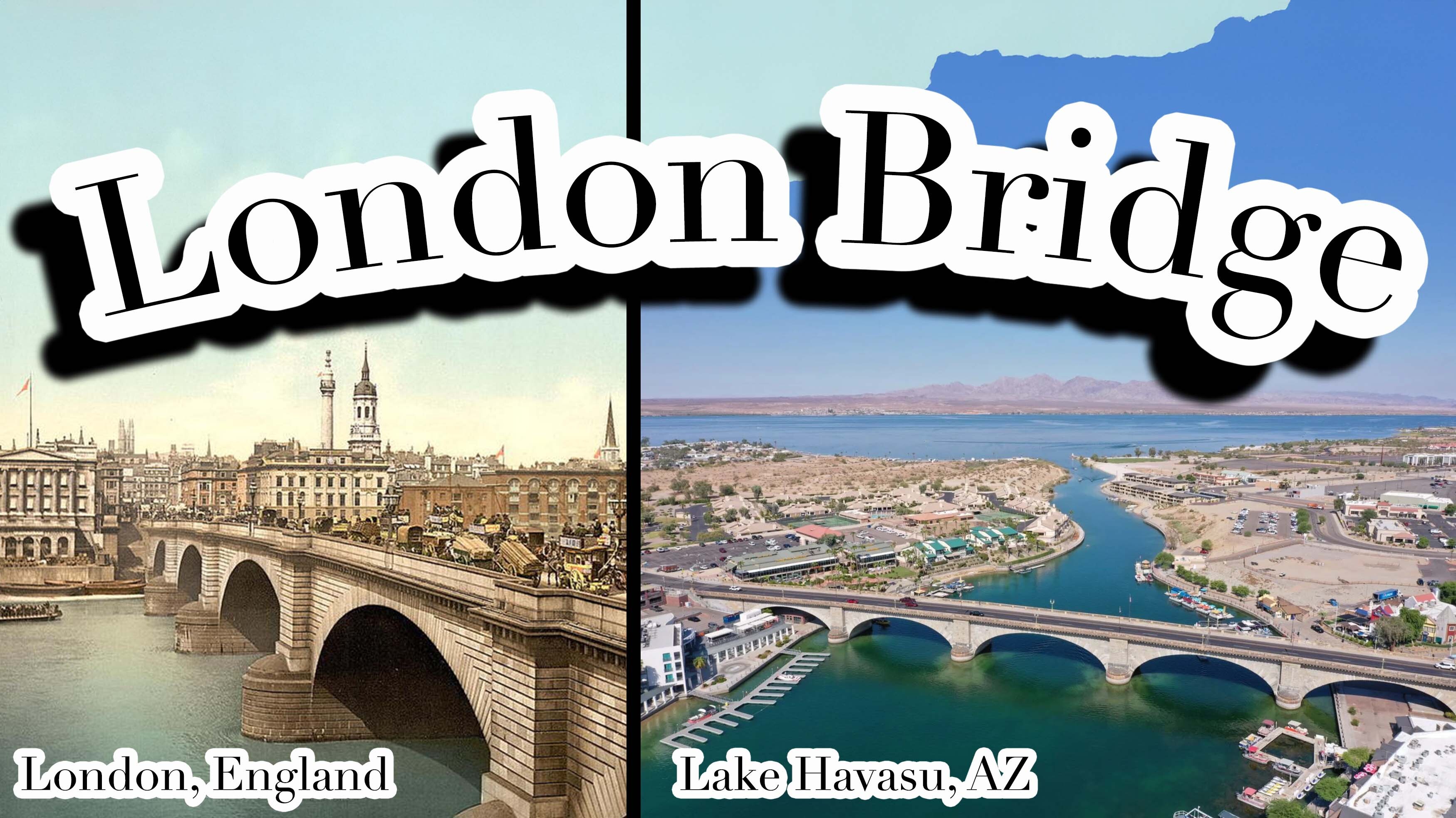London Bridge is Falling Down (and coming to America)
Did you know that London Bridge is in Arizona? In this episode, we talk about the history of London Bridge, it’s several iterations and how it came to exist in Lake Havasu City, AZ. Then we play the quiz with Comedian, Writer and Actor Dan Wilbur!

When I first started learning about this week’s story, I made the same mistake that a lot of non-British people probably make. I thought the iconic bridge that we see associated with downtown London was known as London Bridge. But no. That’s Tower Bridge and a completely different thing. Tower Bridge – the appropriately named bridge connecting to East London across the River Thames was built in 1894 and an icon that will forever be associated with London. It’s the one with the towers that you’ve seen. It raises with a bascule in the middle.
And while our story doesn’t focus on Tower Bridge, I did find a fun story about it.
Back in 1952 this guy named Albert Gunter was doing what he did every day: drive the Number 78 Bus in London. He’s headed toward Shoreditch and driving over Tower Bridge and didn’t realize the bridge was opening. And just like that scene in the Blues Brothers movie where they jump the car over the open bridge – Albert had no choice but to gun it. He was too far and made the decision that the only way out of this situation was forward. So Albert slams on the gas and JUMPS a city bus through the air over the gap in the opening bridge. The reports I read said that the bus was only going 12 miles an hour – which seems WAY too slow. But however fast he was going, he got his bus – with all 20 passengers across the bridge safely. He was the only one injured when he broke his leg. And yes. It was a double-decker bus.
So that’s Tower Bridge. London Bridge, however – is a completely different bridge. This is the next bridge to the West of Tower Bridge. It’s the oldest Thames crossing in London and if you go back, there were a series of “London Bridges,” going all the way to Roman times and 50 AD. The bridges back then were made of Timber and before that there’s some evidence that there was an even more simplistic pontoon bridge. But in 1209, they built what’s known as “Old London Bridge” which is the bridge that they were singing about in the popular children’s song “London Bridge is Falling Down.” And we know that because Old London Bridge was in use until 1831 and that song started showing up in the late 1600s and was first published in the 1700s.
And the origin of the Song, otherwise known as “My Fair Lady,” has multiple stories. There are some weird ones, like the belief that the bridge would collapse unless humans were sacrificed and put into the foundations of the bridge. This is probably linked to some alternate lyrics that were used over the years in which different types of fixes to the bridge are presented and then excused for different reasons. With that said, I’ve never seen a verse that says “kill a guy to please the gods, please the gods, please the gods” or whatever. There’s also an alternate origin story for the song about Vikings sacking the town and stealing the gold.
But the most likely origin for the song is that the bridge was literally breaking down. This was a bridge 926 feet long supported by 19 piers and arches and a wooden drawbridge. And it was in use for more than 600 years. During that time, there were two collapses of the bridge, neither one of them destroying the whole bridge. There were also several fires. This version of the bridge had houses and shops on it. It had waterwheels for power at the bottom and decapitated heads on top. The heads of traitors were dipped in tar and place on spikes on top of the bridge. At one point, there were more than 30 heads on top of Old London Bridge. Toward the end of this bridge’s life, they removed the houses and widened the roadway, but it was in need of total replacement.
So in 1799, they held a competition for designs of the new bridge. The winning design was by John Rennie and included 5 stone arches spanning the River Thames. The foundation was laid in 1824 and was built in the same place as the Old London Bridge. This would be the final project of Rennie’s career – a career that had made Rennie well-known for designing bridges and canals. The New London Bridge, as it was being called at the time, cost £2.5 million – the equivalent of about £320 million today. A huge part of that cost was tied up in remaking the approach roads to the bridge, which cost something like 3 times the cost of the bridge itselfg. This new Victorian stone arch bridge opened in 1831 and became one of the busiest spots in London. At the height of its use, it saw the traffic of 8,000 pedestrians and 900 vehicles every hour. But this was the 19th century. It was created just before a time when the definition of “vehicle”was about to change dramatically. It was handling more and more weight every year. And it began to sink.
The New London Bridge was getting old. And by old, I mean it was 137 years old. Nothing like the age of the Old London Bridge. And by global standards, there were much older bridges. But that 137 had seen a huge change in the way people traveled over it. The difference between 1831 and 1968 was huge.
London Bridge was falling down. It was literally sinking an eighth of an inch every year. And it wasn’t sinking equally on each side. In 1924, it was reported that the East side of the bridge had sunk about 4 inches more than the West side. This combined with the overall sinking of the bridge and the fact that it was never designed for modern automobiles meant that the New London Bridge would have to be replaced.
And in most cities, this would mean that they scrap the bridge while building the new one. But a member of the Common Council of the City of London, Ivan Luckin, had an idea that they should sell the bridge. How do you sell a bridge? Well if you remember our story about Wichita Falls Texas and the World’s Littlest Skyscraper, we talked about how George C. Parker regularly sold the Brooklyn Bridge. Apparently it’s pretty easy to sell a bridge. And in Parker’s case the whole thing was a scam. In the case of the City of London, they decided to actually sell the bridge. They put the bridge up for sale in 1968 and that April, it was purchased.
The new owner of the London Bridge was an American. An Oil Entrepreneur from Missouri by the name of Robert P. McCulloch had made a fortune with his company McCulloch Oil and by selling chainsaws. He also had success in selling motors and superchargers. He purchased London Bridge for $2,460,000. You may be asking – when you buy a bridge, how do you then get it to America? The answer is that you take it apart, brick by brick.
They disassembled London Bridge while carefully marking each brick so it could later be reassembled. That applied to the granite facing blocks anyway – a lot of the blocks from the bridge were sent to a quarry in Devon. The rest were put on a cargo ship and sent through the Panama Canal to California. The blocks were then put on trucks and shipped to Robert P. McCulloch’s new home. Lake Havasu, Arizona.
At Lake Havasu, a popular vacation spot South of Las Vegas, right on the California/Arizona Border, the blocks arrived and were ready to be reassembled. This time, they’d be placed on a hollow-steel core frame that McCulloch had arranged to be pre-built for the granite blocks. It would span the Bridgewater Channel, which is a man-made waterway running through Lake Havasu City. It was completed and dedicated on October 10th, 1971 and when completed, it looks just like the bridge looked when it spanned the River Thames.
While this was going on, a New, New London Bridge was being built in London. It’s known as the Modern London Bridge and is the bridge that exists there today.
But in the city of Lake Havasu, Arizona, you can go and see London Bridge today. In many respects, it’s THE London Bridge. The one that was built because London Bridge was falling down. It’s the bridge that stood through two World Wars in Europe. It stood through 5 Kings and 2 Queens. It saw the world develop during the Industrial Age. And I don’t think many people know about it. That makes it a great story for this show. The Internet Says it’s True.

Review this podcast at https://podcasts.apple.com/us/podcast/the-internet-says-it-s-true/id1530853589
Bonus episodes and content available at http://Patreon.com/MichaelKent
For special discounts and links to our sponsors, visit http://theinternetsaysitstrue.com/deals

